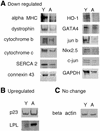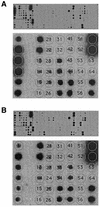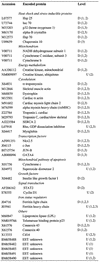Gene expression profiling of the aging mouse cardiac myocytes
- PMID: 12202764
- PMCID: PMC137419
- DOI: 10.1093/nar/gkf497
Gene expression profiling of the aging mouse cardiac myocytes
Abstract
Heart disease remains the most frequent cause of death in the general population with increasing incidence in the elderly population. The pathologic failure of the aging heart may be related to structural and functional alterations in cardiac muscle cells. However, the molecular mechanisms underlying the aging-related decline in cardiac muscle function are largely unknown. To provide the first analysis of cardiac aging at the level of gene expression, we established and compared cDNA libraries from apparently healthy young and aged mouse ventricular cardiac muscle cells. We report the identification of genes that exhibit aging-related changes of mRNA levels. Aging expression profiles in aged hearts indicate decreased cellular adaptation and protection against stress-induced injury together with the development of contractile dysfunction. The data suggest reduced activity of the mitochondrial electron transport system and reduced levels of cardiac-specific transcription regulators. The cardiomyocyte aging profile of gene expression displays similarities with known heart disorders. Genes whose mRNA levels change with aging in cardiomyocytes might profoundly affect pathological changes in the heart.
Figures




Similar articles
-
NOS1 induces NADPH oxidases and impairs contraction kinetics in aged murine ventricular myocytes.Basic Res Cardiol. 2015 Sep;110(5):506. doi: 10.1007/s00395-015-0506-5. Epub 2015 Jul 15. Basic Res Cardiol. 2015. PMID: 26173391
-
The impact of age and frailty on ventricular structure and function in C57BL/6J mice.J Physiol. 2017 Jun 15;595(12):3721-3742. doi: 10.1113/JP274134. Epub 2017 May 14. J Physiol. 2017. PMID: 28502095 Free PMC article.
-
Gene expression profile in dilated cardiomyopathy caused by elevated frequencies of mitochondrial DNA mutations in the mouse heart.Cardiovasc Pathol. 2005 Mar-Apr;14(2):61-9. doi: 10.1016/j.carpath.2005.01.006. Cardiovasc Pathol. 2005. PMID: 15780797
-
Diurnal profiling of neuroendocrine genes in murine heart, and shift in proopiomelanocortin gene expression with pressure-overload cardiac hypertrophy.J Mol Endocrinol. 2008 Sep;41(3):117-24. doi: 10.1677/JME-08-0050. Epub 2008 Jun 12. J Mol Endocrinol. 2008. PMID: 18550896
-
Cardiac System during the Aging Process.Aging Dis. 2023 Aug 1;14(4):1105-1122. doi: 10.14336/AD.2023.0115. Aging Dis. 2023. PMID: 37163425 Free PMC article. Review.
Cited by
-
Autophagy and cardiovascular aging: lesson learned from rapamycin.Cell Cycle. 2012 Jun 1;11(11):2092-9. doi: 10.4161/cc.20317. Epub 2012 Jun 1. Cell Cycle. 2012. PMID: 22580468 Free PMC article. Review.
-
Microarray analysis of gene expression profiles of cardiac myocytes and fibroblasts after mechanical stress, ionising or ultraviolet radiation.BMC Genomics. 2005 Jan 18;6:6. doi: 10.1186/1471-2164-6-6. BMC Genomics. 2005. PMID: 15656902 Free PMC article.
-
Age-dependent expression of ion channel genes in rat.Korean J Physiol Pharmacol. 2023 Jan 1;27(1):85-94. doi: 10.4196/kjpp.2023.27.1.85. Korean J Physiol Pharmacol. 2023. PMID: 36575936 Free PMC article.
-
In vitro aged, hiPSC-origin engineered heart tissue models with age-dependent functional deterioration to study myocardial infarction.Acta Biomater. 2019 Aug;94:372-391. doi: 10.1016/j.actbio.2019.05.064. Epub 2019 May 27. Acta Biomater. 2019. PMID: 31146032 Free PMC article.
-
Transcriptome analysis of ageing in uninjured human Achilles tendon.Arthritis Res Ther. 2015 Feb 18;17(1):33. doi: 10.1186/s13075-015-0544-2. Arthritis Res Ther. 2015. PMID: 25888722 Free PMC article.
References
-
- Vijg J. and Wei,J.Y. (1995) Understanding the biology of aging: the key to prevention and therapy. J. Am. Geriatr. Soc., 43, 426–434. - PubMed
-
- Finch C.E. and Tanzi,R.E. (1997) Genetics of aging. Science, 278, 407–411. - PubMed
-
- Perls T.T., Bubrick,E., Wager,C.G., Vijg,J. and Kruglyak,L. (1998) Siblings of centenarians live longer. Lancet, 351, 1560. - PubMed
-
- Kang P.M., Haunstetter,A., Aoki,H., Usheva,A. and Izumo,S. (2000) Morphological and molecular characterization of adult cardiomyocyte apoptosis during hypoxia and reoxygenation. Circ. Res., 87, 118–125. - PubMed
-
- Terman A. and Brunk,U.T. (1998) Lipofuscin: mechanisms of formation and increase with age. APMIS, 106, 265–276. - PubMed
Publication types
MeSH terms
Substances
Grants and funding
LinkOut - more resources
Full Text Sources
Other Literature Sources
Medical
Molecular Biology Databases

